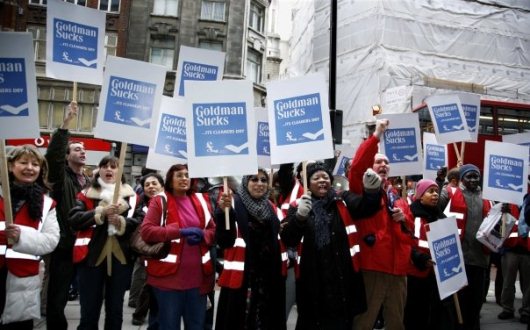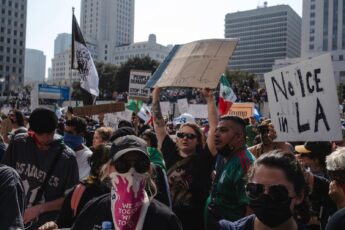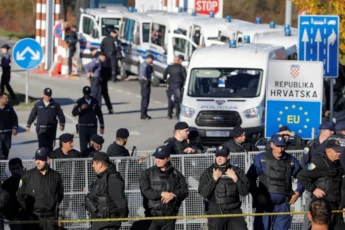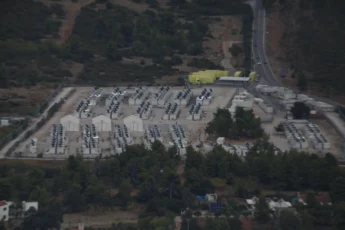
Interview to Valery Alzaga*: From the US May Day of 2006 to Present Challenges
* Trade unionist and organizer for migrants’ rights with experience in the US and Europe, now member of UNISON (UK)
by PRECARIOUS DIʃCONNECTIONS
As part of the discussion opened by the call for a «day without us»on the 20thof February in the UK, and after the publication of an analysis of the strike of migrant labour of the 1st of March 2010 in Italy, we publish an interview to Valery Alzaga. Valery, whose experience as migrants’ organizer spread from the US to several European countries, starts discussing «24 Hours without us» of 2006 in the US. Valery tells us about the organization of the strike, the meaning of that May Day and how, from Chicago to Los Angeles, the fear and the anger daily felt by migrants were transformed into something politically productive: the migrants on strike understood that they had power, the power not to be alone. This struggle, that was essentially social and transnational, speaks to our current struggles and offers useful insights in the search for a strike that is able to overcome the boundaries of the workplaces and of the national dimension. How can we strike when the strike is less and less a right and must hit both the production and the reproduction in order to be effective? How can we fight back a neoliberal model in which the government of mobility becomes an integral part of a process that defunds welfare state and precarizesthe labor force? How can we create political connections between EU and non-EU migrants, between migrants and non-migrants going beyond sheer solidarity and overcoming the divisions that weaken us all? In the end, how can the «si se puede» force resonate in the present, starting from the 20thof February? These are some issues at stake in Valery’s interview. A continuation of this discussion will take place on Saturday 11th during the TSS Assembly in London.
ConnessioniPrecarie: The Mayday of 2006 remains in the memory as the day of the migrants’ strike in the US, when millions marched on the streets and blocked a considerable part of US economy. The main urgency behind the mobilization was the opposition to a new law criminalizing illegal immigrants; can you give us some insights on the wider process that led to that day?
Valery: Before 2006there had been decades of organising in many important cities where migrant labour is fundamental, in the service economy, (in my case) in the cleaning sector, in the food sector, in the domestic work sector, in the agricultural sector. The legal attack on migrants was so obviously harsh that there was no way out of that. People had to realize that if we didn’t stand up, it would have been much harder for undocumented migrants to live in the U.S., as we were being criminalised.We were standing up not only for our safety and our families, but also for the families we feed back home.So it was a meaningful space, but it was organized by a lot of groups that have been previously gaining ground, in labour and at the community and religious level– with full support of the migrant local and national media.
It is important for migrant subjectivitynot to be the victim but to really understand the value we bring to the economy. The marches were fundamental for us to understand we have power, we have power to articulate, to generate huge amounts of migrant communities in resistance, we have the ability to use our own media, to use our labour power, or purchasing power.In labour in particular, which is my focus, we had been by then already winning a lot and developing organizing models that were very much about the community being involved and about solidarity being built and about social unionism, being a space where people could not only rally but turn out others to vote even if they were undocumented.
CP:Different sources led to that day, starting from the memories of the Si Se Puede movement of the 1970s. There were also different views during the mobilization campaign: the We Are America coalition or slogans such as «we didn’t cross the border, the border crossed us» pointed out to different kind of discourses. Can you tell us something more about the composition of the movement and its outcomes?
V: There were a lot of tensions and difficult ongoing negotiations with the Democratic Party about the legalization fight. Something that came out of that May Day was a sense that we could not only go from a defensive position, but there was the promise of a legalization, of a regularization. And yet, it didn’t happen. And as time went by, it became much harder.The movement itself began being very fragmented, from the people that were very critical, especially with unions that were making these deals, to organizations that felt we needed to be more deliberate and more on the streets. In a way, we could have done so much more, we could have actually hit the streets more often, in order to show the fact that there was a critical mass not only of migrants, but key players supportive of migrants, including employers, including politicians that believed that the legalization was possible and needed. We were able to stop the worse of the national legislation and in local and state levels get some legislation. We have been able to win many local fights that allowed us for driver’s licence, or the ability to go to the healthcare without having to be checked for migration. The developments of sanctuary cities: there, the migrant movement has been effective and getting more rights. If you look at 2006 and where the major of these huge turnouts happened, there happened to be in the cities where most of the labour force is.But if you also look at places like California, and in particular L.A. and San Francisco, or New York or other areas, you also see that some of these cities ended up having a very forward thinking in terms of having a sanctuary city position towards the federal government, towards not developing internal borders but actually defending the rights of migrants to be citizens of a city, residents of a city with as much rights as anybody else. Even if we cannot do it nationally we have been able to stake out very powerful spaces where migrants have a voice and where migrants mobilize votes and even if we are undocumented we can mobilize our own community that can vote and our support bases that can vote. Some unions definitely took very moderate positions when they should have been a bit more militant because we are not only talking about migrants, we are talking about employers that depend on these migrants. So what you have is a combination of interests that could have pushed the right agenda.
CP: How do you understand the role of the strike in this picture?
V: Concerning the strike as a big event of one day:it doesn’t work. It works when it’s an increasing, escalating process where you are taking more and more small victories. I don’t think that symbolically is enough anymore. We got to work on all the different levels – municipal levels, city levels, state levels, federal levels, and global level.In the US we know that – you can see that with justice for janitors and other kind of migrant labour organizations – the strike is just one of our tools, important as it is. You can call for big action days but it has to serve a very local goal, it has to serve a very municipal goal, it has to serve a very specific goal, even if the goal is just mobilizing more people. In the case of 2006, there had been a lot of building actions in many cities, a lot of organising on the ground, a lot of media/radio mobilisation that culminated on the «day without us» strike and us ultimately stopping the proposed anti-migrant legislation.The strike of Mayday was a powerful winning moment, no doubt, but it was the culmination of an escalation, not a single hit event.
CP:A day can also be used to open up new spaces, taking the force of the fact that there is bigger visibility or a big moment, also to shift the boundaries of labour struggle, of strike itself. For example, in the smaller scale, the experience of migrant strike that we had in Italy on the 1st of March 2010. In some situations this actually helped to raise questions that had never been raised before: how to strike in specific situations? How can a home-based worker strike? How can workerswithout the formal right to strike go on strike? What can you say about these different issues in relation with May Day 2006?Is there anything we can learn?
V: What worked is that it was a social strike: students were out there and churches were out there and everybody was out there. You were not just not working, you were not consuming and if you were taking care of kids, either you involved your employer to understand that they needed to almost come with you or that they needed to allow you to do this or you were just calling in sick and resisting. There were a lot of different spaces where things were negotiated. In the big employers where you had contracts, they were asked literally to allow for people to go to these demonstrations. There was a time limit but people were allowed to do so. In other cases, people just walked out, they were just like: «I’m not gonna ask for permission! This is our day!» But I think it produced a kind of “audacia”, an audacious moment where the risk of all of us doing all of this was less than me just doing it by myself. It reproduced a sense. That’s why it felt like everybody was doing it.
Again: there is no question that one-day can shift the discourse. On the other hand, I do think that the social strike is broader than the labor strike. My experience is that the labor strike in this age won’t work unless there is a social support mechanism, especially when migrants feel supported by their own institutions, be it the churches or the unions, their neighbors or the schools of their kids and their own media (which play an essential role). When we connect the dots, it makes more sense because we are all in conjunction and we try together to raise our floor above ground.For me the social strike is almost the only way in which you can do something. Look at it from a logistical point of view: if migrants didn’t strike with their children, they actually brought the children out with them, but if they didn’t do that, this would mean that they would have had to leave the kids to somebody, that was supposed to work then. We are able to articulate a solidarity level that is very powerful. It doesn’t only produce a safety net, but the power of knowing that you are not alone in this, that all these institutions cannot be wrong. The anger and the fear were overwhelmed and transformed into something very productive.
CP: Let’s jump now on the other side of the Atlantic and let’s talk about your experience as organizer in Europe. What kind of connectionsor differences do you see? We can just mention one example of a political problem we face in Europe, that is the limits of organizing at the national level, which are particularly evident in the case of migrant labor. More widely, how do you translate all the problems we mentioned before in the European context?
V: I think that a common ground is that migrant labor has become very important in Europe, very vital in some sectors. I am right now organizing in the care sector, and you know it’s an interesting space: in a way it is very national, but in another way there is also an influx of migrants in it. You got this kind of space where this very precarized labor force is actually intertwiningcitizens and migrant workers. Yes, we can do a great job showing the strength of migrants and in Europe this is more challenging because I don’t think the unions have a tradition of investing resources on organizing migrants. In a way organizing the precarious service space where most migrants are is a challenge for the unions. They are traditionally active in a Fordist situation, where their core is stable employment or retired people, so I wouldn’t say that the unions have done a great job in organizing migrant labor or precarious labor. We should do a better job of linking it with non-migrant labor. There are enough labor organizations and sectors that have a little migrants’ representation, but I don’t see this articulation right now. On the ground what is interesting is how we are organizing migrants and non migrants in the same sector, how we take part together in the fight against the rising xenophobia, the fight against blaming the migrants for neoliberal forces, against the defunding of the welfare state. In my current experience I am engaged in trying to organize workers ofa hospital in an area where the Brexit vote was very high, but this hospital has a shortage of medical workers and so it has to be filled by migrants. There are spots where the country hasn’t produced its own medical workforce, for policies that I cannot even begin to understandso the whole system depends on migrant labor, nurses, doctors, all kind of workers, EU and non-EU migrants. We are doing a kind of EU and non-EU migrant organizing campaign in the hospitals to get them organized, unionized, to join especially the EU workers for the campaign to remain and for the non-EU workers to make sure that they are included in the professions that are exempted from incomes of 35,000 pounds a year. The new regulation is that if you don’t do 35,000pounds a year you have to leave the country. So many of the professions have to be exempted because they don’t reach the level but they are necessary for the economy. On the one hand, we have the EU workers and the campaign to remain and the social rights that come from having to bargain something like a Brexit, because it is not just the right to remain, it is also the right for your pensions if you go back home, for healthcare reciprocity if you go back and forth between two countries that had an agreement and now they don’t have it anymore. But on the other hand you have a lot of migrants that have less rights: so we have migrants that have less privilege and then migrants, like EU migrants, that are under attack but have more privilegeand more access to rights. You can’t just be a EU-workers’ campaigner… because you have to go against the xenophobic attacks in the workplaces suffered by EU and non-EU migrants as well and people of color. But the interesting thing is that the moment I go to a hospital to organize migrants and migrants’ rights we find an environment in which British workers are brexiters – for the wrong analysis perhaps, also because the union didn’t campaign very well on this – so you have a reaction that can be actually more negative, because you have a polarized workforce. The challenge is to organize across the sectors, organize a campaign about defending the NHS, healthcare and the rights endangered by the Brexit, but the main thing is to stress how defending migrants means defending oneself, the pressure posed to the labor of all others. We have to come up with a much more sophisticated message.
CP: On the 20th of February «one day without us» has been called in the UK – taking inspiration from the experiences of 2006 in the US and 2010 in France and, above all, Italy. Even though the legal strike is very difficult to declare, there are voices in the movement around this date that are calling it a migrant strike. How do you see this and what is going on in terms of migrant organizing and claiming after the Brexit?
V: Unions are in a constrained space as far as the possibility of declaring a strike is concerned. I just moved to the country and I can’t say to be very embedded in the migrants’ movement beyond my union. Much will depend on what will be negotiated. I think that there is a potential, and support.Half of the country wants to remain.There is a momentum in the migrants’ community, there is fear but also anger. People are getting organizedfrom different organizations, from Polish workers, Spanish workers, Philippine workers… there is not only lobbying, but also community organizing happening. It can be that tomorrow some disastrous measure is proposed, and then we will hit the streets. I have a sense of urgency on the migrants’ side. There is the willingness to move and to do something and join something: what I am seeing is a positive migrants’ rights movement emerging out of this. It is now the moment to organize also non-migrants. I think that a social strike helps when there are non-migrants involved. And it is very important to have this strategy very well lined up. This makes us stronger.On the other hand,it is important to consider that many migrant workers are not formally organized in a union or other organizations, and fear taking action (most likely because they have never done it)… Striking is a huge step and a strong form of defiance which requires enough anger and a clear sense of hope… but that feeling of strength has to be created and that’s where effective organizing, disseminationand community alliance work come in.
CP: As part of the Transnational Social Strike Platform we arediscussing the connections between migrants and non migrants, taking into account the difference of the migrants, meaning the institutional racism and the specific condition of migrant labor, the dimension of strike across classical unionism – the social strike dimension – and the needs of a transnational level. How do you see the potentialities and the need to develop tools – we call it a «political infrastructure» – able not only to connect, but to develop common perspectives, ideas, claims that we can use in different places?
V: I would say we need that more than ever, because this is a European problem. The xenophobia and the exclusion that we are seeing migrants are going through is a European phenomenon, it is not just related to Brexit. The problem isthat we have very little counterpower. In my view we as left or progressive forces are very weak, because we have been fighting a losing fight against neoliberalism for many years. We can fight symbolically but this is not enough. There have to be spaces where progressive politics isgaining ground. I don’t think unions are the only solution. Italy is a space where you have seen it historically: you don’t need majoritarian unions; you can do in other ways. On the one hand, we need it more than ever, we need the articulation of a European movement, and we need to kind of rely on each other’s practices, and on the other hand we need to be more concrete. I don’t think we will be able to stop this fascist neoliberal attacks any time soon unless we begin winning in the political spaces where we have it. So in my view again I am hopeful, although you have a Trump you have a progressive scene and many (linked) cities ready to stand up against him. In Europe you have this kind of forces, but places like Barcelona or Madrid are spaces of hope where migrant rights are central to the discussion, it is a political space to gain more power, including the protection of migrants. In my view I am organizing in spaces that are being «undone». What I define as being «undone» is precisely the dismantling of the welfare state, the dismantling of the commons, the dismantling of labor rights or whatever you want to call it. In social care, in nursing homes, you got a neoliberal model that is precarizing the labor force, and migrants are coming in, and at the same time you are destroying the very infrastructure with equity funds, with a whole lot of neoliberal processes… they are breaking down the very sector that is most needed because Europeans are getting older. If you look at how cities are managing their crisis and the way they are choosing to manage their social care, or their education, or their sanidad, most of the choices that are happening in Europe are leading toward an American model of precarized labor, where migrants will probably become more needed, because in a lot of ways their salaries are so low that either the Europeans accept these labor conditions or migrants become the backfield for it. For me labor is not in a vacuum and it’s necessary to begin unionizing those spaces.
Europe is unraveling in (1) the way in which is doing its economic city management; (2) the privatization, the private employers, the private housing speculation, all the things that attack our lives are in a neoliberal sense moving very fast. And yet, our movements are still symbolic. Our movements have to be about taking control of our cities, in sectors where migrant workers and non-migrant workers are. Winning local rights, regulations and better distribution of wealth is where we can build real power. To me that’s where the space of struggleneeds to happen. We were beginning to organize domestic workers in the Netherlands, through the unions, that is not normal that the unions have a domestic sector in it. It’s organizing mostly undocumented workers. And it was effective in organizing them and the clients that we were taking care of. The domestic field is precisely where there’s an articulation between the necessity of migrant labor and the necessity of better care, and the necessity of having new political cities that respond to these needs. It’s where a social strike is most effective, because the problem is if you just get migrants speaking. But you don’t get the reason why the migrants are here speaking and why they are needed.
CP: There is a difference in stressing that migrants state their own value, or also their own power, and on the other hand, stressing the fact that we need migrants. Don’t you think there is the need to developa discourse inside the labor movement in which the common interest of non-migrant workers and migrant workers can join?
I believe very much in the autonomy of migration, that they can be protagonists of struggle. They’re not victims. But that’s not enough. We need campaigns that should be, first of all, a message to ourselves. How do we as migrants organize ourselves? And then the message has to be very tailored to what we are going through, and what we want and why. And then there is another discourse. A good campaign has to speak to many audiences and has also to be a message understood to be for non-migrants. Our audience shouldn’t be the usual suspects only, the migrants, the leftists, etc. In a way we have to understand there is a middle ground that has to be moved from different self-interests as well as social interests. I mean, what the very important thing is to do is an argument on why migrants are not to blame for this crisis, how the neoliberal agenda is what’s breaking the social services, the welfare state and the healthcare. Not migrants. When we break it down and explain this to workers, workers understand what these policies are and who is behind these interests. It is the lack of regulation that is allowing for these neoliberal ways of extracting value. So, just because I’m a pro-European, it doesn’t mean that I don’t understandhow that is connected to national discontent and migration. I have to be able to explain how migrants have been scapegoated. In that analysis, I think we’re lacking, we need to make it more masticable and easy for migrants as well as non-migrants to understand the effect of quality of life declining in Europe, the effect of Britishworking poor, on Italians working poor or whatever. There are a lot of migrants that will internalize the fact they are a burn on society. So, we need to say no! Let’s really look at what that’s happening and what are the forces that are actually making the situation what it is. We have to work more on this. Some of the intellectual’s milieus that we are part of get it but I don’t know how much we’re able to translate that with the base. And not because we’re enlightened. Because I’m not saying «hey migrants, look at this, you don’t know this». They know. They live it. The question is: how do we campaign in a way that really explains the forces that are benefiting from this discourse and how we need to shift the discourse in a way that is about also uniting working class people.
CP: How do you see all these things in relation with labor struggles? We know many places where migrant labor is also used to divide workers. So, the very last point would be how do you fit all these issues inside the organizing of the work places to show perhaps the common interest against the employer, sometimes, or against the contractor if you are working in a subcontractor.
V: There is a methodology of how campaigning is most effective. But, as an example, we organized baggage handlers in the airports. The first generations of workers were unionized, with strong contracts, but they were a shrinking minority of workers. The rest of the workers were subcontracted, outsourced, and they were mainly migrant workers, with no contracts, no unions, and no rights. So, we organized also the workers that were against these migrants because in their minds they were undermining their contracts, their standards, seeing themas a threat.So, we had to organize both. We had to bring them into the same room to speak to each other about their perspectives. It was interesting but we needed to bring an analysis of the company. How was the company using this divide and conquer? Why was it happening and how we collectively needed to put pressure not on the subcontractor of the company but on the clients?In this case, it was a combination of private and city. The interesting thing I’m saying though is how we show workers where the money was going, how this architecture of outsourcing and loss of standards was actually the future of the privileged workers as well if we didn’t fight back jointly… their standards would be gone but their floor was what we needed to defend and get everyone to. All of us. Equal pay for equal work, it was the slogan. And this may take several fights, but it’s a strategic process. Now, the workers did it. The outsourced workers, the normal workers together, but then we had social movements supporting them. So when they went to the city, and they went to the contractor, if they strike, if they did action, there would be also supporters outside. We also involved other kinds of players in the mix, because we also did a critique on safety, that this kind of precarious conditions were a safety problem. So, we tried to get a message not to the usual suspects, but to the users about why it is important to raise standards. So, my point is that campaigning is not just having solidarity, it is having the plan to win and is having the plan to really get the right analysis of how you win to the workers that are taking these risks and these steps as well as to the allies that are building the campaign with them. So, I do think that for a very important decade, 5 to 10 years, we are gonna be fighting all the time at many different levels. It will be important to go from reactive to pro-active, from symbolic to strategic and chirurgical when it comes to the financial and political interests behind the neoliberal machine.We have to do city politics, labour negotiations and lobbying work… and win.I think we are gonna have to fight. There is no question. The question is how? And the question is for what?
First published on: http://www.connessioniprecarie.org/2017/02/07/migrants-strike-an-audacious-moment-an-interview-with-valery-alzaga-from-the-2006-us-may-day-to-present-challenges/





